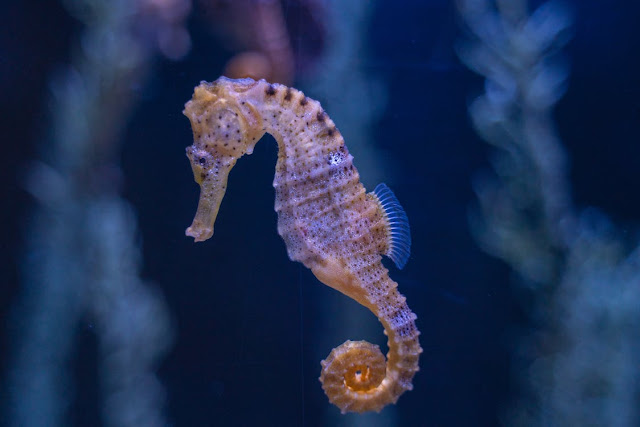Seahorses are fascinating and unique marine creatures belonging to the family Syngnathidae, which also includes pipefish and sea dragons. They are instantly recognizable by their unusual appearance, with a horse-like head, elongated snout, and prehensile tail. Seahorses are found in oceans all around the world, inhabiting coastal areas with seagrass beds, coral reefs, and mangroves.
Physical Characteristics:
- Body Shape: Seahorses have a distinctive upright body posture, with a curved neck and a long tubular snout. Their bodies are covered with bony plates, giving them a hard exoskeleton.
- Tail: The tail of a seahorse is prehensile, meaning it can grasp and hold onto objects. It is used for anchoring to surfaces, such as seagrass or coral, and for maintaining stability in strong currents.
- Fins: Seahorses have two dorsal fins on their back, which undulate rapidly to propel them forward. They also have pectoral fins on either side of their head that help with manoeuvring.
Reproduction and Parenting: Seahorses have a unique and fascinating method of reproduction. The female seahorse transfers her eggs into a specialized brood pouch located on the male's abdomen. The male then fertilizes the eggs within his pouch. He carries and protects the developing embryos until they hatch. This role reversal, with males carrying the babies, is one of the rare instances of male pregnancy in the animal kingdom.
Social Behaviour: Seahorses are relatively solitary creatures and are often found alone or in pairs. However, during the breeding season, they engage in elaborate courtship displays and rituals to find and bond with a mate. Some species of seahorses are known to form monogamous pair bonds that can last throughout the breeding season or even longer.
Feeding Habits: Seahorses are carnivorous and primarily feed on tiny crustaceans, such as copepods and small shrimp. Their tubular snout acts like a straw, allowing them to suck up their prey with precision and accuracy. Seahorses are ambush predators and rely on their excellent camouflage and stealth to surprise their prey.
Conservation Status: Seahorses face several threats that affect their populations in the wild. Habitat destruction, including the degradation of coral reefs and seagrass beds, is a significant concern. The aquarium trade and traditional medicine practices also contribute to seahorse declines. Many species of seahorses are currently listed on the International Union for Conservation of Nature (IUCN) Red List as vulnerable or endangered.
Conservation Efforts: Various organizations and initiatives are working to protect seahorses and their habitats. Some countries have implemented regulations on the harvest and trade of seahorses, and conservation programs focus on raising awareness about their conservation status and the importance of preserving marine ecosystems.
Seahorses continue to be a subject of wonder and intrigue for marine enthusiasts and researchers alike. Their unique biology, behaviour, and vulnerability make them a symbol of the need for marine conservation efforts to protect these captivating creatures and the delicate ecosystems they inhabit.


No comments:
Post a Comment